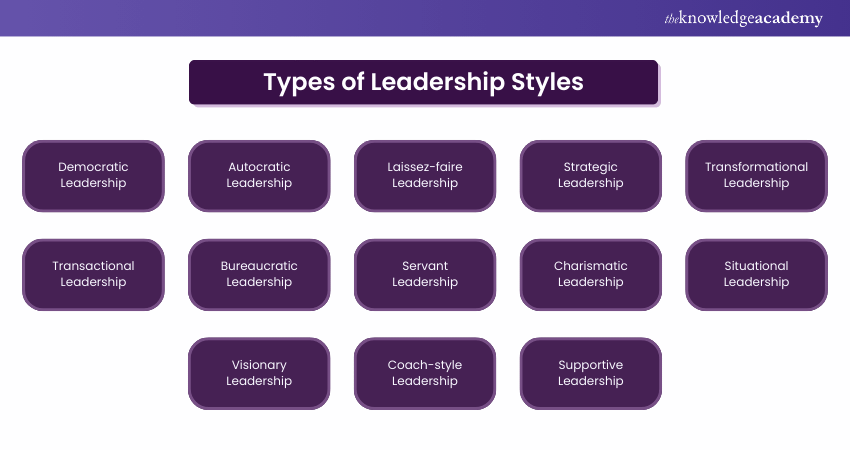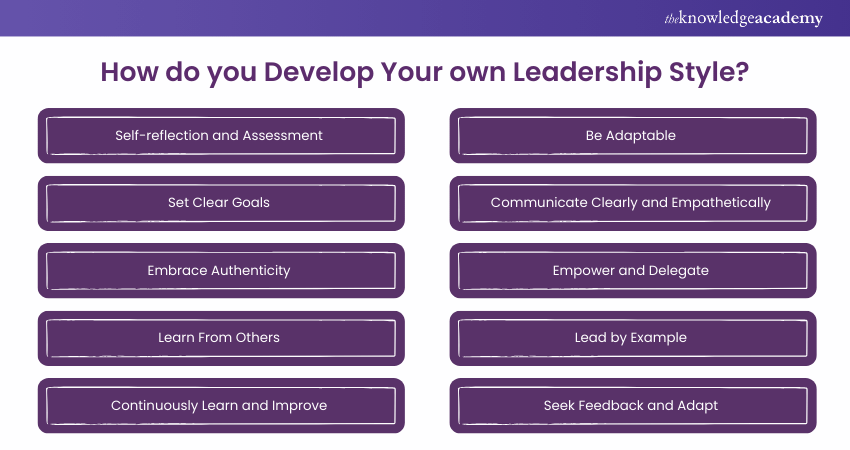We may not have the course you’re looking for. If you enquire or give us a call on +1800812339 and speak to our training experts, we may still be able to help with your training requirements.
Training Outcomes Within Your Budget!
We ensure quality, budget-alignment, and timely delivery by our expert instructors.

Leadership is the secret sauce behind every thriving company. But what makes a leader stand out? It’s not just about quick decisions or a friendly team vibe. It’s about knowing the right way to lead. Each Type of Leadership Styles has its own superpowers and kryptonite, influencing how leaders rally their troops towards victory.
Ever noticed how some bosses are like cheerleaders, getting everyone pumped, while others can’t seem to get the team to sing the same tune? It’s all about the different Types of Leadership Style. Ready to unlock the Leadership technique that’ll take you and your squad to the top? Let’s jump into the world of Leadership Styles and find the one that fits you like a glove!
Table of Contents
1) A Brief Introduction to Leadership
2) 13 Different Types of Leadership Styles
3) Which Leadership Style is the Best?
4) Importance of Knowing Your Leadership Style
5) How to Find Your Leadership Style?
6) How do you Develop Your Own Leadership Style?
7) Conclusion
A Brief Introduction to Leadership
Leadership is the capacity to influence, inspire, and lead individuals or groups towards achieving common goals. It's more than mere authority; it's about motivating and assisting teammates reach their greatest potential.
Effective Leadership involves understanding the diverse Type of Leadership Styles, each with its own strengths and challenges. Whether it's the inclusive nature of democratic Leadership, the decisiveness of autocratic Leadership, or the hands-off approach of laissez-faire, each style impacts team dynamics and goal achievement differently.
Successful Leaders modify their approach to fit the changing needs of their teams and organisations, resulting in a good and productive work environment. Individuals who understand multiple Leadership Styles can become more Effective Leaders, producing positive change and achieving success.
13 Different Types of Leadership Styles
Leadership is a multifaceted concept encompassing various approaches to lead and influence individuals or groups towards achieving common goals. Let's delve into the details of some prominent Leadership Types:

1) Democratic Leadership
This is one of the most practised Types of Leadership Styles in the modern world. Democratic Leadership is characterised by its inclusive and participative nature. Leaders who adopt this style actively involve their team members in decision-making processes. They also seek their opinions, ideas, and feedback. By valuing their team's contributions, democratic leaders foster a sense of ownership among employees.
Characteristics:
a) Encourages Team Participation: Team members are actively engaged in making decisions.
b) Promotes Open Collaboration: Appreciates open communication and the sharing of ideas.
c) Empowers Through Delegation: Managers give power to their team and have faith in their skills.
d) Fosters Creative Solutions: Inspires original ideas and varied answers.
2) Autocratic Leadership
Autocratic Leadership is a traditional and authoritative approach where the leader holds absolute decision-making power. In this style, leaders seldom seek input from their team members, making decisions based on their own judgments and expertise.
The Authoritative Leadership Style emphasises building strong connections with each team member to offer personalised guidance and feedback, promoting individual success. Leaders employing this approach must demonstrate adaptability, especially as their team expands.
While Authoritative Leadership skills involve hands-on engagement, leaders must exercise caution to avoid micromanagement tendencies. Overbearing involvement can lead to negative sentiments among team members. Striking a balance between active guidance and allowing autonomy is crucial for fostering a positive work environment and ensuring that the Authoritative Leadership Style remains effective without stifling the team's initiative.
Characteristics:
a) Centralised Decisions-making: The leader has sole authority in making decisions without seeking input from the team.
b) Minimal Team Input: Directions are provided with limited opportunity for flexibility and discussion.
c) Strict Control Over Tasks: The leader exerts complete control and closely oversees tasks.
d) Focus On Efficiency: Team members have little participation in the process of planning or solving problems.
3) Laissez-faire Leadership
Laissez-Faire Leadership grants maximum autonomy to team members. Leaders adopting this style delegate decision-making authority to their team and refrain from intervening in day-to-day operations.
While it can effectively foster creativity and independent thinking, it might lead to a lack of direction or coordination within the team. Some employees may thrive in such an environment. On the other hand, others may struggle with the absence of clear guidance and support.
Therefore, the Laissez-Faire Style requires a highly skilled and self-motivated team that can handle responsibilities effectively without constant supervision.
Characteristics:
a) Minimal Supervision: Leaders offer limited guidance, enabling independence in decision-making.
b) Empowerment: Team members are given the freedom to investigate ideas and solutions.
c) Trust in Team: Team members trust leaders to have confidence in their abilities and their ability to manage themselves.
d) Limited Feedback: Leaders provide infrequent feedback, encouraging individuals to take ownership of their actions.
Empower yourself to lead confidently with our Women's Leadership Training – Join now!
4) Strategic Leadership
Strategic leaders challenge entrenched assumptions in the workplace and encourage employees to voice alternative perspectives. In their managerial role, strategic leaders craft a tactical vision for the organisation and inspire their team to embrace it. A significant strength of strategic leaders lies in their capacity to assess various options and make decisions that contribute to the company's growth.
Characteristics:
a) Visionary Thinking: Ability to articulate a clear future direction.
b) Adaptability: Being able to adjust to evolving surroundings.
c) Long-term Focus: Prioritising sustainable objectives over immediate profits.
d) Collaborative Mindset: Promoting teamwork and inclusive strategies through a collaborative mindset.
5) Transformational Leadership
Transformational Leaders inspire and motivate followers toward exceptional outcomes. They have a clear, compelling vision for the future. Transformational Leaders lead by example, exhibiting enthusiasm. They instil a strong sense of purpose in team members.
Strategic Leadership comes with significant strengths and challenges. It motivates team members to strive for excellence and dedication, promoting a culture of positive transformation within the company.
However, this Type of Leadership Style may encounter difficulties as it depends greatly on the leader's charisma to inspire and involve individuals. Moreover, it requires genuine communication of the vision to ensure that all individuals are aligned and strive towards shared objectives.
Characteristics:
a) Inspirational Motivation: They motivate teams with a clear vision and zeal for goals.
b) Individualised Consideration: They support individual growth and development through mentorship.
c) Intellectual Stimulation: They foster creativity by challenging norms and welcoming new ideas.
d) Charismatic Influence: They build trust and loyalty through their strong presence and charisma.
6) Transactional Leadership
Transactional Leadership is one of the commonly sighted Types of Leadership Styles. It is based on a simple exchange between the leader and their team members. It involves setting clear expectations, providing specific guidelines, and rewarding individuals for meeting predefined goals and objectives. Conversely, it also includes consequences for failing to meet expectations.
Transactional leaders focus on managing day-to-day tasks and performance. This ensures that the team adheres to established rules and procedures. While they can effectively maintain structure and discipline within the team, this style may not encourage innovation or long-term growth. Team members might become solely focused on fulfilling immediate targets rather than thinking strategically about the organisation's future.
Characteristics:
a) Clear Structure: Establishing a clear structure of the roles and expectations of team members.
b) Reward and Punishment: Encourage performance by offering rewards and consequences.
c) Focus on Short-term Goals: Emphasises specific, quantifiable results.
d) Directive Approach: Offers precise instructions and requires compliance.
7) Bureaucratic Leadership
Bureaucratic leaders adhere strictly to established rules and procedures. While they may consider employee input, any suggestions conflicting with company policies or historical practices may be dismissed. Key features of this Leadership Style include the following:
a) Centralised decision-making
b) Rigorous adherence to rules
c) A clear chain of command
d) Limited autonomy
Bureaucratic Leadership is most effective in larger, older, or traditionally successful companies, aiming to maintain existing processes. These businesses prefer sustaining their current strategies, avoiding experimentation that could potentially waste time and resources.
While it may pose Leadership Challenges, the Bureaucratic approach offers several benefits. It minimises the risk of favouritism, providing job security and predictability. This structured Leadership Style can foster high levels of creativity in some employees.
While not as restrictive as Autocratic Leadership, Bureaucratic Leadership may limit individual freedom in roles, potentially stifling innovation. It may not be suitable for companies pursuing ambitious goals and rapid growth.
Characteristics:
a) Rule-Oriented: Focuses on closely following set rules and procedures.
b) Hierarchical Structure: Functions within a distinct organisational structure with specific positions.
c) Focus on Efficiency: Gives priority to efficiency and effectiveness in procedures.
d) Limited Flexibility: Not easily adaptable to change, depending on inflexible structures.
8) Servant Leadership
Servant Leadership is one of the altruistic Types of Leadership Styles that places the leader's focus on serving their team members and meeting their needs. Leaders practising this style prioritise the well-being and development of their employees. They actively listen to their team's concerns, offer support, and provide growth opportunities.
By putting their team first, servant leaders create a nurturing and positive work environment that fosters trust and loyalty. Employees feel appreciated, which leads to higher job satisfaction and improved team performance. However, this style may require a delicate balance between serving others and making critical business decisions to ensure overall success.
Characteristics:
a) Empathy: They prioritise understanding team members' needs and feelings.
b) Active Listening: They value team input and foster open communication.
c) Growth Commitment: They support the personal and professional development of team members.
d) Community Focus: They emphasise collaboration and a strong sense of belonging.
9) Charismatic Leadership
Charismatic Leadership centres around the charm, magnetism, and persuasive abilities of the Leader. Charismatic Leaders captivate and motivate their followers through their sheer presence. They articulate a vision with passion, instilling a sense of purpose in team members. Charismatic Leaders create strong emotional bonds with followers, fostering loyalty and commitment.
Transformational Leadership possesses numerous advantages, one of which is its capacity to incite enthusiasm and commitment within team members. This Type of Leadership motivates teams to work together towards common objectives, resulting in a dedicated and involved staff.
However, it comes with difficulties like excessive dependence on the leader's character, leading to reliance on their charm. If a leader's charm decreases, it can harm team productivity, showing the significance of consistent Leadership approaches.
Characteristics:
a) Magnetic Personality: Charismatic individuals draw in and involve supporters with their mesmerising charm.
b) Strong Communication: They motivate others by clearly and passionately expressing their ideas.
c) Confidence and Conviction: Their belief in themselves inspires followers to back their cause.
d) Emotional Connection: Loyalty is nurtured through strong emotional connections and understanding.
10) Situational Leadership
Situational Leadership emphasises adaptability and flexibility in Leadership types. It depends on specific situations and the maturity level of team members. Leaders using this approach assess the readiness and capability of their team to perform certain tasks and adjust their style accordingly. For example, a team with less experience may require more guidance and direction, while a more experienced team may benefit from greater autonomy.
Situational leaders are skilled at assessing the needs of their teams and providing the appropriate level of support to help them succeed. This approach can be highly effective in diverse and dynamic environments.
Characteristics:
a) Flexibility: They adapt their approach to suit team needs and tasks.
b) Directive and Supportive: They balance clear direction with emotional support.
c) Assessment Skills: They evaluate team members' competence and commitment to tailor their style.
d) Collaboration: They foster open communication and involve team members in decision-making.
11) Visionary Leadership
The Visionary Leadership Style involves being able to establish and effectively convey an inspiring vision for the future. Leaders who utilise this approach inspire and motivate their teams by presenting a clear direction and purpose. They promote innovation and creativity by encouraging team members to think creatively and welcome new ideas. This innovative approach creates a space where people feel empowered to actively participate and bring about meaningful changes.
Visionary leaders are also adept at cultivating strong relationships among their team members. Their focus is on effective communication, actively engaging with team members' insights and feedback. By fostering trust and teamwork, they establish a feeling of joint ownership and dedication to the goal. This Leadership approach boosts organisational development and improves employee involvement and contentment, as team members feel appreciated and aligned with a greater purpose.
Characteristics:
a) Inspiring Vision: They communicate a compelling vision that inspires teams toward a common goal.
b) Innovative Mindset: They foster creativity and encourage new ideas.
c) Strong Communication: They precisely communicate goals and encourage open dialogue.
d) Empowerment: They allow independence and involve team members in decision-making.
12) Coach-style Leadership
Coach-style Leadership focuses on growth in both personal and professional aspects by providing mentorship and guidance. Leaders who follow this approach focus on developing solid connections, promoting transparent dialogue, and nurturing trust. They offer feedback that assists team members in recognising their strengths and areas needing improvement, enabling individuals to achieve their maximum capabilities and improve overall performance.
This method works well where teamwork is important and ongoing learning is valued. Leaders who adopt a coaching approach help team members set goals and develop skills by crafting individualised growth strategies. Using active listening and motivation methods, they encourage employees to take responsibility and be accountable, resulting in a successful and creative work environment.
Characteristics:
a) Mentorship Focus: They guide team members' personal and professional development.
b) Open Communication: They encourage honest dialogue and active listening.
c) Feedback-oriented: They offer constructive feedback to identify strengths and areas for improvement.
d) Goal Setting: They help team members set and achieve personal and professional goals.
13) Supportive Leadership
Supportive Leadership emphasises creating a positive workplace by putting the well-being and concerns of team members first. Leaders who embrace this approach prioritise transparent communication, compassion, and comprehension, establishing a secure environment for staff to share their opinions and issues. Supportive leaders enhance team cohesion and morale by offering emotional support and encouragement, which helps in building strong relationships.
This Leadership Style works well where cooperation and working together are crucial. Encouraging leaders engage in attentive listening toward their team members, acknowledge their inputs, and offer valuable feedback. By doing this, they enable employees to be responsible for their work, increase their self-assurance, and promote career development, resulting in higher productivity and job fulfilment.
Characteristics:
a) Empathy: They actively listen to team members' concerns and needs.
b) Encouragement: They acknowledge efforts and celebrate achievements to motivate employees.
c) Open Communication: They promote transparency, ensuring comfort in sharing ideas.
d) Collaboration: They involve team members in decision-making and value their input.
Master the art of Team Handling with our Successful People Management And Team Leadership – Sign up now!
Which Leadership Style is the Best?
There is no one Leadership Style that works well for every organisation or situation. Furthermore, there is no single correct way to lead, and leaders might have to adjust their approach depending on the situation. It is essential to understand the different Leadership Styles and their individual pros and cons. Several factors can influence the most suitable Leadership approach, such as:
a) The type of organisation, mature or focused on growth, impacts its nature
b) The category of task, whether it is repetitive or innovative
c) The team's level of experience and skill
d) The character of the leader
Taking these factors into account can assist in deciding on the most appropriate Leadership Style or a blend of styles to implement.
Importance of Knowing Your Leadership Style
Understanding your Leadership Style is crucial for effective management and fostering a positive work environment. It enables you to tailor your approach, provide meaningful guidance, and make informed decisions. Awareness of your Leadership Style also sheds light on how employees perceive you, aiding in addressing potential areas for improvement.
For instance, if feedback suggests an oppressive atmosphere, it may indicate an autocratic style requiring adjustment. Recognising your Leadership Style fosters self-reflection and empowers proactive enhancements. Importantly, it allows you to anticipate challenges associated with specific types, encouraging continuous development and creating a workplace where employees feel heard and valued.
Enhance your decision-making skills today with our expert-led Decision Making Course- Register now!
How to Find Your Leadership Style?
Choosing a Leadership Style that fits your personality can greatly improve your success as a leader. The way you lead your team, whether big or small, greatly impacts how they see you. Below are a few suggestions to assist you in getting started:

a) Clarify Your Goals: Clearly state your desired outcomes. Having a clear vision simplifies communication and motivates your team to support your direction.
b) Experiment with Styles: There are various styles of Leadership available. Experimenting with various methods is the most effective way to determine what is most effective for you and your team.
c) Lead Authentically: Leadership is not about being flawless; it's about being real. When you lead with enthusiasm and a clear goal, others are naturally attracted to you and what you have to say.
d) Seek Feedback: Proactively seek and welcome feedback. As a leader, it is essential to be open to changing your strategy in response to feedback in order to continually improve.
By taking these factors into account, you can create a Leadership approach that is effective for you and encourages and energises your team.
How do you Develop Your own Leadership Style?
Developing a unique and effective Leadership Style is a journey of self-discovery, continuous learning, and intentional growth. Aspiring leaders can follow these essential tips to develop their own style:

1) Self-reflection and Assessment
So, begin by reflecting on your values, strengths, weaknesses, and experiences. Further, seek feedback from colleagues, mentors, and team members to gain different perspectives on your approach.
2) Set Clear Goals
Define your Leadership goals and the impact you want to create as a leader. Setting clear objectives will help guide your development process. It will also help you shape your style towards achieving your vision.
3) Embrace Authenticity
Authenticity is the cornerstone of effective Leadership Qualities. Be true to yourself and lead with integrity. Embrace your unique qualities and experiences. These abilities can set you apart as a leader and foster genuine connections with your team.
4) Learn From Others
Study the styles of successful leaders you admire, both within your industry and beyond. Also, identify the aspects of their style that resonate with you and consider how you can integrate those elements into your own style.
5) Continuously Learn and Improve
Invest in your personal and professional development. Attend workshops, seminars or training programs to enhance your skills and knowledge. Seek mentorship from experienced leaders who can offer guidance and support on your journey.
6) Be Adaptable
Effective leaders are adaptable and versatile. Understand that different situations and teams may require different approaches. Moreover, be open to adjusting your style based on the needs of your team and the challenges at hand.
7) Communicate Clearly and Empathetically
Communication is vital for Leadership success. Develop strong communication skills, both in conveying your vision and actively listening to your team members' perspectives. Moreover, show empathy and understanding to build trust and rapport.
8) Empower and Delegate
Encourage the growth and development of your team members by empowering them with responsibilities and autonomy. Also, delegate tasks and trust your team to deliver results. Creating a culture of trust and empowerment fosters a sense of ownership among team members.
9) Lead by Example
Actions speak louder than words. Lead by example and embody the values you wish to see in your team. Demonstrate a strong work ethic, resilience, and a willingness to learn from mistakes.
10) Seek Feedback and Adapt
Regularly seek feedback from your team to assess the effectiveness of your style. Be open to constructive criticism and use it as an opportunity for growth. Continuously refine and adapt your approach based on feedback and experiences.
Become an Agile Leader and drive success with our Leadership Courses today!
Conclusion
Mastering the diverse Type of Leadership Styles is your gateway to becoming an exceptional Leader. Each style offers unique advantages that can motivate, and guide your team to new heights. Embrace the flexibility to adapt your approach to different situations. Your journey to outstanding Leadership and organisational success starts here!
Learn to motivate your team with our Staff Motivation Training – Register today!
Frequently Asked Questions

Leadership Styles refers to the usage of different methods to lead and inspire the teams. These behaviours, attitudes, and strategies impact team dynamics, decision-making, and performance, shaping Leadership effectiveness in various situations.

Some of them include transformational, democratic, situational, transactional, supportive and autocratic Leadership Styles. Each style comes with a distinct feature, allowing leaders to adapt their approach.

The Knowledge Academy takes global learning to new heights, offering over 30,000 online courses across 490+ locations in 220 countries. This expansive reach ensures accessibility and convenience for learners worldwide.
Alongside our diverse, Online Course Catalogue encompassing 17 major categories, we go the extra mile by providing a plethora of free educational like News updates, Blogs, videos, webinars, and interview questions. Tailoring learning experiences further, professionals can maximise value with customisable Course Bundles of TKA.

The Knowledge Academy’s Knowledge Pass, a prepaid voucher, adds another layer of flexibility, allowing course bookings over a 12-month period. Join us on a journey where education knows no bounds.

The Knowledge Academy offers various Leadership Courses, including the Leadership Skills Training, Agile Leadership Training, and Women's Leadership Training. These courses cater to different skill levels, providing comprehensive insights into Agile Leadership.
Our Business Skills Blogs cover a range of topics related to ISO, offering valuable resources, best practices, and industry insights. Whether you are a beginner or looking to advance your Leadership skills, The Knowledge Academy's diverse courses and informative blogs have you covered.
Upcoming Business Skills Resources Batches & Dates
Date
 Successful People Management and Team Leadership
Successful People Management and Team Leadership
Fri 10th Jan 2025
Fri 28th Feb 2025
Fri 4th Apr 2025
Fri 16th May 2025
Fri 11th Jul 2025
Fri 19th Sep 2025
Fri 21st Nov 2025







 Top Rated Course
Top Rated Course



 If you wish to make any changes to your course, please
If you wish to make any changes to your course, please


